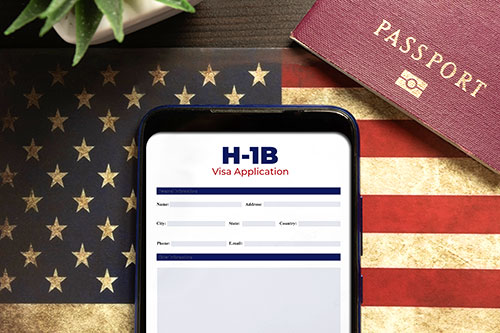Immigration: A Potential Fix for Labor Shortages?
Reforms to U.S. immigration policy may help to supply more of the workers needed by companies that might otherwise choose to locate in other countries.
Workforce Q4 2023

The reality, though, is that while the pandemic may have exacerbated the problem and called a lot of new attention to it, this was an issue that was brewing well before the coronavirus began stirring up trouble. That means the solutions go beyond getting a handle on COVID-19, and it has had some observers wondering if the workers America needs can be found elsewhere in the world. Could changes in immigration policy help fill in the labor gaps?
“Without a doubt, this is the most acute workforce shortage I have seen in 15 or 20 years,” observes Larry Gigerich, executive managing director of Ginovus, a location and site selection consulting firm based in the Indianapolis suburb of Fishers. “It has been magnified by the fact that from before COVID to today, we’ve had four million people leave the workforce. That is a huge number of people to lose. The second thing is longer-term, a 15-year trend line of the birthrate dropping so much.”
Indeed, statistics suggest that the number of job openings has for more than a decade increased far more quickly than the working-age population. A policy paper from the nonprofit Niskanen Center notes that job openings rose about 12 percent a year between 2011 and 2021, while the working-age population grew annually by just a third of a percent. That suggests a significant long-term problem emerging well before the “Great Resignation” amid the pandemic.
A Mismatch of Skillsets
Adding to the population challenges, Gigerich says, is a mismatch in skillsets between what’s needed and what’s available. “Part of it is technology disruption, whether in the office environment or even more so in manufacturing and logistics. There’s a vast amount of robotics and automation, which has changed the kinds of people needed to work in those facilities and how many,” he says. But he adds, the problem “ranges from highly skilled professional engineering jobs all the way through entry-level positions in retail, hospitality, and food services.”
Chris Volney, a managing director of client strategy with CBRE’s labor analytics team, works a lot with technology and life-sciences companies with big needs from the knowledge-based workforce. He agrees that the issue predates COVID, when there seemed to be slowdown in the availability of candidates arriving from overseas by way of H-1B visas, which allow American employers to bring in foreign workers to fill various specialty occupations.
Immigration, particularly through the H-1B process, has provided a good source of expertise among the kinds of tech and life sciences companies with which he often works. That source is just not what it used to be, and Volney concurs that it’s an issue across a wide range of sectors. For example, “it’s also manufacturing and warehousing — they have historically relied on immigrant labor, too, and they are suffering also.”
Statistics suggest that the number of job openings has for more than a decade increased far more quickly than the working-age population. Navigating the H-1B Visa Process
Part of the problem may lie in the H-1B process itself, he says. “It’s difficult to navigate people through that process,” Volney explains. “It could take months or years.”
Indeed, hiring a foreign worker through the H-1B process requires multiple applications. Employers must prove that they’re planning to pay potential immigrant workers whatever the prevailing wage that American workers would receive for that job in that area. They must file a separate application establishing the job’s qualifications in a specialty occupation. Meanwhile, citizens of most other countries must make application at their U.S. consulate to obtain an H-1B visa. And once they are headed to America, they must apply for admittance at the port of entry.
Beyond that complicated process, a major H-1B roadblock is the annual quota, according to Maria Kallmeyer, Chicago-based immigration counsel for the firm Quarles & Brady. “There are only 85,000 H-1Bs a year, and they run out immediately,” she observes. A lottery in March determines who may be eligible to come to the U.S. and start work in October, and Kallmeyer says the chances of winning that lottery are as low as one in 10.
One more issue is that current immigration law only has mechanisms for welcoming foreign workers with at least a bachelor’s degree. “There is no real category for people with less than a bachelor’s degree,” Kallmeyer says, which can stand in the way of hiring immigrants for many different jobs, from welders to assemblers to nurses.
An Easier Process in Canada
Volney imagines how the American bureaucratic challenge might appear to a foreign opportunity-seeker who just earned a technology degree and is ready to apply that knowledge somewhere. The United States has historically been an attractive place to pursue a career, but what if some of your graduating classmates are finding it a whole lot faster, easier, and more certain to aim for a place like Canada?
Canada offers a highly instructive contrast when it comes to the welcome mat that foreign workers observe, he suggests. “What has happened in Canada [is that] they saw an opportunity with what was going on in the U.S.,” he says. “Their immigration system is more merit-based. If you have a degree in computer science or other technology fields, they’re approving those guest worker visas in two weeks. That takes away a lot of risk for people emigrating and adds a lot more certainty.” Canada has found successful ways to tap into immigration to support specific needs in its economy.
That’s one reason why a lot of top technology talent is now headed for Canada, Europe, and elsewhere, rather than the U.S. Volney points to a recent analysis in The New York Times in which the author interviewed more than a dozen highly educated professionals who were educated in China and then left for greener pastures elsewhere. “I was most surprised to find that most of them had moved to countries other than the United States,” writes the interviewer, Li Yuan. “China is facing a brain drain, and the United States isn’t taking advantage of it.”
Why is that? The author observes, “most of the emigrants I spoke to, explaining why they did not pick the United States, cited America’s complicated and unpredictable process for applying for visas and permanent resident status.”
Gigerich agrees that Canada has found successful ways to tap into immigration to support specific needs in its economy. For example, Canadian leaders recognized the need to bolster the workforce in areas related to technology, research and development, and countless other fields. Their realization: “You can’t create them fast enough organically in your own workforce, so you have to turn to immigration as a tool,” he says. “Canada has done a very good job addressing that from the top end.”
The Effect on Companies’ Location Decisions
The big picture, Volney says, is that immigration as a labor source — enabled by such tools as the H-1B visas — has not kept up with the needs of American employers. “That was a talent pool that a lot of tech companies were relying on, and they’re being forced to source that more from the domestic audience,” he says.
That leads to another concerning twist — will that trend cause some expansion projects to land in other countries? Volney says some location searches that in the past might have focused mostly on U.S. sites seem to be turning more global in their gaze. “I think that is in part due to immigration policies,” he notes.
Gigerich agrees that it’s an issue that complicates the important task of growing American business: “We need to figure it out, because if we can’t have the talent that is needed to fill positions, they’ll be forced to go other places where they can find that talent.”
Immigration as a labor source — enabled by such tools as the H1-B visas — has not kept up with the needs of American employers. What Changes Are Needed?
If changes to immigration policy might help fill vacant positions in the U.S., what might those changes look like? It should come as little surprise that any solutions will be a challenge to create and implement. Immigration policy has been a political dilemma for years.
“Immigration reform is the answer we certainly need, and it has been many years, since the 1990s, that we have had any real immigration reform,” Kallmeyer says. “I don’t think there is an appetite for it.” If policymakers were to develop that hunger for change, she offers a number of ways they could make a difference. One of the simplest would be to get rid of the 85,000 quota for H-1B visas and establish a market-based cap instead. “There is no reason for an artificial quota,” she says.
Then there’s the issue of no easy path for immigrants eager to fill jobs needing less than a bachelor’s degree. Creating more immigration categories is a potential solution waiting to happen, Kallmeyer adds.
She also notes the irony that America has been simultaneously experiencing a major influx of migrants at the southern border while lamenting a labor shortage to the north. “I have people calling me from both angles,” she says. “I have clients calling me saying ‘I need people to work here.’ And I have clients calling saying ‘we want to help the migrants, is there something we can do for them?’”
Of course, connecting those dots or implementing any kind of immigration solution is not the least bit simple, or else it might have happened by now. Gigerich notes that the sometimes-chaotic situation at the southern border can complicate the political climate needed to find immigration solutions.
That said, he imagines there could be a path toward increasing the number of work visas, which would provide some labor relief. “That’s probably where you could get fairly good discussion on a bipartisan basis,” he says. “We are an innovation services economy — we need to fix that part. I think you are seeing the business community in the last two years become the most united they ever have been, saying we are putting our economic future at risk.
Project Announcements
Kikkoman Foods Plans Jefferson, Wisconsin, Operations
04/26/2024
BWX Technologies Expands Cambridge, Ontario, Nuclear Production Operations
04/26/2024
Greenheck Group Plans Knoxville, Tennessee, Operations
04/26/2024
Local Bounti Plans Pasco, Washington, Indoor Agricultural Operations
04/26/2024
Innovative Construction Group Plans Siler City, North Carolina, Production Operations
04/26/2024
Crystal Window and Door Systems Plans Mansfield, Texas, Headquarters-Production Operations
04/25/2024
Most Read
-
2023's Leading Metro Locations: Hotspots of Economic Growth
Q4 2023
-
2023 Top States for Doing Business Meet the Needs of Site Selectors
Q3 2023
-
38th Annual Corporate Survey: Are Unrealized Predictions of an Economic Slump Leading Small to Mid-Size Companies to Put Off Expansion Plans?
Q1 2024
-
Making Hybrid More Human in 2024
Q1 2024
-
Manufacturing Momentum Is Building
Q1 2024
-
20th Annual Consultants Survey: Clients Prioritize Access to Skilled Labor, Responsive State & Local Government
Q1 2024
-
Public-Private Partnerships Incentivize Industrial Development
Q1 2024



